The benefits of having a home gym are seemingly endless — no commute, increased privacy, and tailored equipment to match your wants and needs. If that sounds enticing, there are a few home gym equipment you’ll need. Arguably, the most important is your home gym flooring.
Finding the best flooring for your home gym is a little more complicated than laying down an extra exercise mat before your next set, however. You need to consider how much space you want to cover, the material of the floor you’re planning on covering, and how much you can afford to spend. So, to help lay a strong foundation for your search, our team of BarBend experts tested six different options to narrow down the best home gym flooring for a variety of purposes.
The 7 Best Home Gym Flooring of 2025
- Best Home Gym Flooring Overall: Living.Fit Gym Mat Flooring
- Best Home Gym Flooring Over Concrete: Rubber Flooring Inc 8 mm Rubber Rolls
- Best Soundproof Home Gym Flooring: SecondSkin Stomp Mat
- Best Stall Mats: Tractor Supply Horse Stall Mats
- Best Rubber Flooring for Home Gym: PLAE Forge
- Best Turf for Home Gyms: Rubber Flooring Inc Turf Rolls
- Best Budget Home Gym Flooring: Living.Fit Rubber Flooring Rolls
Best Home Gym Flooring Overall: Living.Fit Gym Mat Flooring
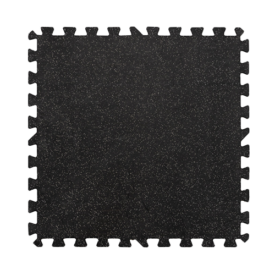
These gym flooring mats go together like a training-ready puzzle, and you can choose between rubber or EVA foam panels depending on how dense you prefer your flooring to feel underfoot. Additionally, the Living.Fit Gym Mat Flooring bundles are budget-friendly at less than $100 for four panels.
Specs
- Price: $69.99
- Material: Rubber or EVA Foam
- Thickness: ⅖”
- Dimensions: 19.02” L x 19.02” W Rubber, 24” L x 24” W EVA Foam
- Pieces Per Order: 4
Pros
- At only $69.99 for four pieces, this is among the most budget-friendly gym flooring.
- These gym floor tiles interlock to keep your entire platform intact during training.
- The ⅖-inch floor tiles are lightweight and easy to disassemble, meaning you can clean up without issues post-workout.
Cons
- The panels can cover between 2.51 and four square feet depending on the chosen material, which isn’t enough for large areas or full rooms.
- Athletes wanting a thicker gym flooring solution can find better options.
- You need to trim these floors.
As you may have noticed, building a home gym isn’t cheap and your workout flooring is no exception. But you don’t have to spend hundreds of dollars with our best home gym flooring overall pick from Living.Fit. We gave these rubber or foam mats (depending on your choice) a 5 out of 5 for value, considering a set of four only costs $69.99 and covers just over 120 square feet.
“For a budget-friendly product, I didn’t expect these mats to be as high-quality as they are,” according to BarBend editorial member Kate Meier, certified personal trainer and weightlifting gym owner. “These are plenty thick and the rubber has an excellent grip.” And after dropping about 300 pounds on these mats from six feet high, they didn’t come unhooked or budge, earning a 5 out of 5 for durability.
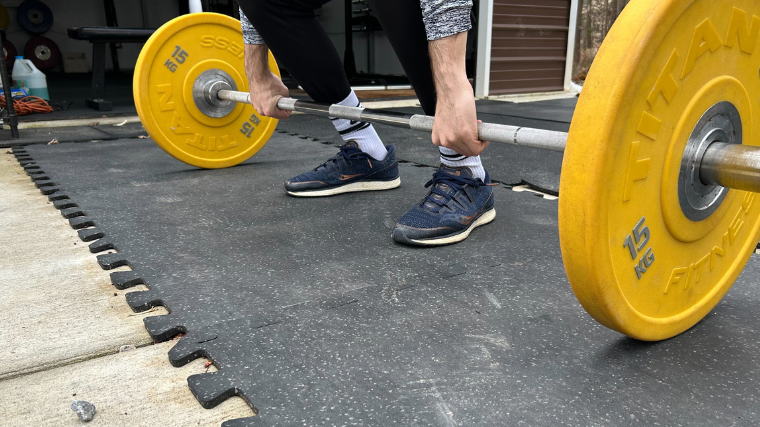
These are an absolute breeze to install, especially compared to some other products, which can involve gluing and taping. All you have to do is interlock the parts like puzzle pieces. “It does take a bit of time to get the rubber to lay flat because it was rolled up,” Meier said, giving the installation a 4 out of 5. “I suggest letting them flatten and then locking them together.”
One installation downside is that you may need to slightly trim the puzzle portions in order to align them perfectly, our testers said. This wasn’t too challenging but for those who want a totally seamless installation, one big flooring piece (like the Stomp Mat) may be more ideal.
“These mats do have a rubbery smell when you take them out of the packaging,” Meier said. “I actually personally love that smell but I know some gym owners may not love it, especially if your gym is inside your actual house, not your garage.”
Best Home Gym Flooring Over Concrete: Rubber Flooring Inc 8mm Strong Rubber Rolls
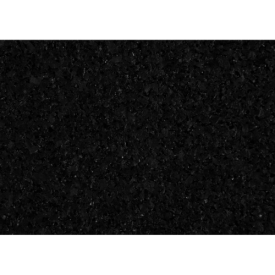
This rubber flooring layers well over concrete and can help protect your floors against dropped weights. These also have zero rubber scent, which you get with some products.
Specs
- Price: Starting at $1.49/square foot
- Material: Recycled rubber and virgin rubber
- Thickness: 8mm
- Dimensions: Varies by order
- Pieces Per Order: Varies by order
Pros
- These mats are thick and can cover concrete without subjecting the ground to damage.
- These are so durable, the company promises they’ll even hold up under cleats.
- You don’t get any rubbery smell with these.
Cons
- Depending on your choice, these can be up to $6.59 per square foot, which is pricey.
- The installation takes a little longer than some competitors.
- You may need to use carpet tape to keep this flooring perfectly in place.
If you’re looking to cover your concrete floor with some high-quality rubber gym flooring, look no further. Rubber Flooring Inc’s 8MM Strong Rubber Rolls are the perfect way to protect your concrete garage or basement.
“When it comes to durability, these hold up well,” according to Kate Meier, a certified personal trainer and owner of a weightlifting gym, who gave these a 4 out of 5 for durability. “I installed these in my CrossFit gym in 2020 and they’re still there. I’ve noticed a few dings when something extreme happens but otherwise, they’re in great condition.”
Installation is a bit of a lengthy process with this pick, earning a 2 out of 5 in this category. You do need to use double-sided tape to keep the rubber rolls in place and you need to cut them yourself. “This process can take hours or days, depending on your space,” Meier said. “I’d recommend hiring a professional if you’ve never done it before.” For those who aren’t comfortable with cutting the rubber, interlocking tiles may be best.
These flooring rolls are made with a combination of recycled and virgin rubber but doesn’t have a strong texture as you see with some other picks. However, you can choose from 24 different colors and the company even allows you to order free samples, so you can see the different options in person before buying in bulk.
“This flooring doesn’t really stifle the noise too much, you can still hear plates slamming,” Meier said, giving the noise cancellation a 3 out of 5. But the floor is definitely cushioned and comfortable enough to lie on directly, which allows for some versatility with floor exercises.
These mats start at $1.49 per square foot but can get pretty pricey. We gave the overall value a 4 out of 5, considering the starting price is pretty approachable. Some of the other colors, though, can go up to as much as $6.59 per square foot, which is among the most expensive on this list. You do get a five-year warranty on home colors and 25-year warranty on the Biggie Smallz color options, which we liked.
Best Soundproof Home Gym Flooring: SecondSkin Stomp Mat
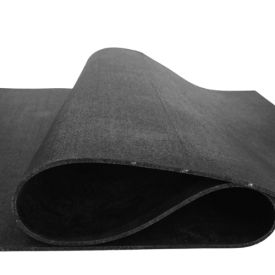
SecondSkin's Stomp Mat is great for those who want to soundproof their home gym as much as possible. This home gym flooring also comes as one large mat piece, which is easy to install.
Specs
- Price: Starting at $99.99
- Material: Recycled rubber
- Thickness: ¼” or ½”
- Dimensions: 24 square feet
- Pieces Per Order: 1
Pros
- These sound isolation mats reduce impact noise, while protecting your floor.
- This gym floor mat has functionality and can be used for machines and weights.
- The installation is simple with no adhesive required.
Cons
- This product is a little pricey but you get free shipping.
- This only comes in a square size but you can order the Stomp Roll for larger spaces.
For a home gym, you may want to keep noise as minimal as possible. In that case, you need soundproof gym flooring, like the SecondSkin Stomp Mat. When it comes to noise cancellation, it doesn’t get any better than this product.
Often used in large laundromats to silence machines, the Stomp Mat isolates sound and reduces impact noise to keep your workouts as quiet as possible. And this mat is plenty durable, earning a 5 out of 5 in that category. It can withstand plenty of use with little to no damage at all.
When it comes to installation, the Stomp Mat is a breeze, earning a 5 out of 5 in this category. Personally, I can’t fathom cutting and gluing rubber floor mats to the ground, so for those who aren’t comfortable with a labor-intensive installation, the Stomp Mat is a solid choice. This one has no adhesive required, all you need to do is lay the mat on the ground. The friction of your machinery holds it in place.
For those who want as much noise reduction as possible, our team recommends getting the half-inch thickness. This one is best for those who plan to drop dumbbells or kettlebells (or other strength training equipment). The quarter-inch mat still works well but is best under cardio equipment.
This product is a bit pricier than some others, earning a 3.5 out of 5 for overall value. It’s about $99.99 for a 24-square-foot mat in the quarter inch and $179.99 for the half-inch size. There are less expensive options on this list but if sound is your main concern, we think the cost is worth the results.
[Related Reading: Best Weight Plates]
Best Stall Mats: Tractor Supply Horse Stall Mats
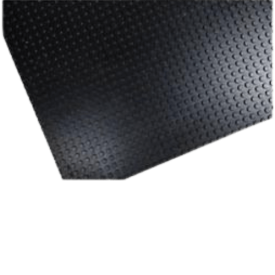
Tractor Supply's Horse Stall Mats are originally intended for barn use but these heavy-duty mats are great for your home gym, too. These can withstand plenty of heavy weight drops and are simple to install.
Specs
- Price: $58.99
- Material: Rubber
- Thickness: ¾”
- Dimensions: 4’ L x 6’ W
- Pieces Per Order: 1
Pros
- These stall mats have plenty of durability and an anti-skid surface.
- These are among the most budget-friendly picks.
- The rubber absorbs vibration to protect your floor.
Cons
- The raised surfaces may be harder to clean than smooth floors.
- These have a bit of a rubber scent.
- These mats are 94 pounds each, which may be too heavy for some to lift.
You don’t need to buy high-end, costly garage gym flooring for every home gym. Stall mats are an excellent alternative and these thick stall mats from Tractor Supply are among the best in their category.
“I’ve used my Tractor Supply mats for years and installed them close to a decade ago,” according to Kate Meier, certified personal trainer and weightlifting gym owner. “I’ve done hundreds of workouts on these mats daily for years and they’ve held up.” Although the color fades a little with time, Meier still gave this flooring a 5 out of 5 for durability.
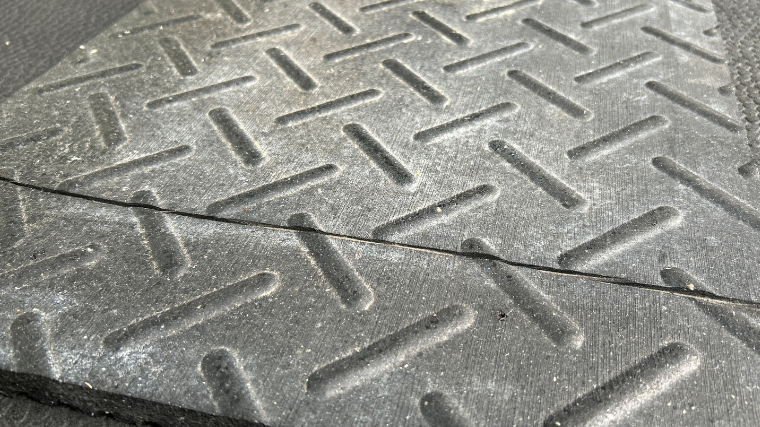
Tractor Supply has plenty of stall mats to choose from, including options with raised surfaces, like our pick. This can be great for grip, especially if you like to do a lot of plyometrics or high-intensity interval training. But this does make the stall mats a little more difficult to clean.
For overall cushion, we gave these a 4 out of 5. “These are very stable and I had no concerns in that respect,” Meier said. “I do put a yoga mat on top of the floors if I’m doing any ground exercises. These aren’t soft enough for many exercises.”
When it comes to installation, these aren’t the easiest, earning a 3.5 out of 5 in that category. They do need to be taped down to prevent shifting, Meier says. “Even then, they tend to shift a tiny bit.” Not to mention, one of the mats is nearly 100 pounds, which isn’t easy to move around.
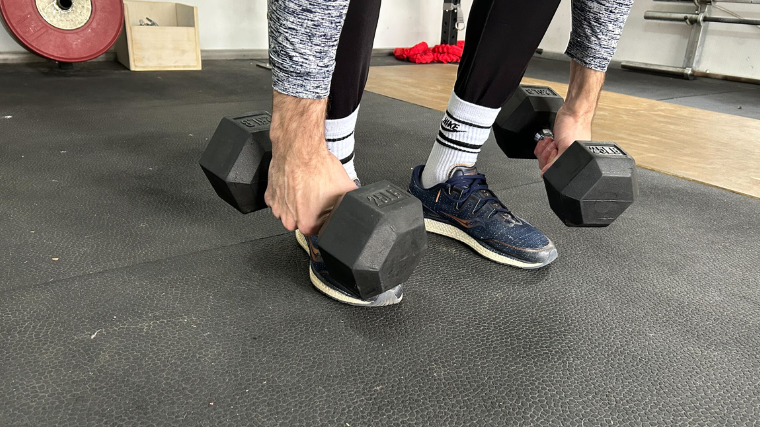
At less than $60 per mat, these are pretty cost-friendly, earning a 5 out of 5 for overall value. However, we don’t love their initial rubbery smell. Plus, since they’re intended for barn use, they may need some extra cleaning before you put them in your home. “These are pretty dirty, especially when you just get them,” Meier said. “They leave black residue on your hands and clothes but that lessens with time.” So, if cleanliness is an issue, you may want to opt for another flooring pick.
Best Rubber Flooring for Home Gym: PLAE Forge
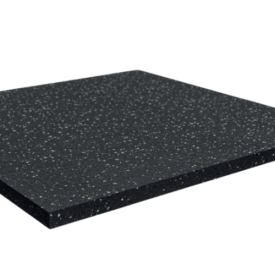
PLAE's Forge flooring is rubber and works well in any home or garage gym. This product is plenty thick and you can buy these as rolls or tiles, depending on what's more convenient.
Specs
- Price: Varies by estimate
- Material: Rubber
- Thickness: 12mm
- Dimensions: 4’ W x 30’ L
- Pieces Per Order: Varies by order
Pros
- The 12mm-thick rubber can help protect the floors in your home gym.
- You can buy these as rolls or tiles.
- There’s little to no maintenance needed.
Cons
- There’s only a black color option.
- The installation process isn’t too simple.
- There are no additional thickness options.
Rubber can be an excellent home gym flooring option for athletes looking to use their training space regularly or house heavy weights/heavy equipment, like treadmills and smith machines, atop the surface. For these demands, we recommend PLAE Forge flooring.
Each panel is 12 millimeters thick and, in our experience, can absorb shock and sound pretty well. The best part about rubber flooring? It’s super grippy under your feet. After trying it myself, I loved the non-slip grip factor because it made certain exercises, like deadlifts, all the more stable. I’d give the texture a 4.5 out of 5. I also didn’t notice the sound carrying much even when I dropped a barbell.
For durability, we gave this flooring a 5 out of 5. In our testing gym, it supports countless treadmills, air bikes, and free weights with zero issue. We haven’t noticed any damage to the floor yet, despite the many workouts our team has performed.
Installation for this gym rubber flooring is not quite as easy as some alternatives, earning a 4 out of 5 in that category. The instruction manual alone is about four pages long and you do need to secure the mats to the ground with adhesive, which isn’t the simplest process.
When it comes to value, the price actually varies depending on your space, so you need to call to get an estimate. However, PLAE Forge does come with a five-year warranty, so if you notice any issues, you can get your money back.
Best Turf for Home Gyms: Rubber Flooring Inc Turf Rolls
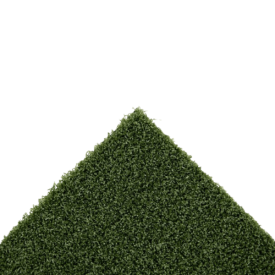
Some athletes may want to upgrade their home gym with some durable turf. These turf rolls can be used indoors or outdoors and offer excellent shock absorption for your high-impact exercises.
Specs
- Price: Starting at $3.19/sq foot
- Material: PE Fiber
- Thickness: ⅜” no pad, ⅝” with pad
- Dimensions: Custom
- Pieces Per Order: Varies by order
Pros
- These durable artificial turf rolls can be used inside or outside to create a grass-like surface.
- This turf has excellent shock absorption.
- Although it may look difficult to clean, maintenance is actually pretty simple.
Cons
- Starting at $3.19 per square foot, this turf is among the priciest picks.
- It can feel harder to ground yourself while weightlifting.
- It doesn’t feel as comfortable as standard mats for floor exercises.
Functional athletes may want the option of adding some turf to their home gym — what a way to take your workout space to the next level. To really upgrade your gym, we love this Performance Turf from Rubber Flooring Inc.
Whereas other turf options are usually made with nylon, these actually use polyethylene (PE) fiber, which feels softer. “My home gym has some turf and I think it’s great for minimizing shock for certain HIIT exercises,” our tester said, giving the durability a 4 out of 5. However, turf isn’t always the best for weightlifting, as it can feel a bit more difficult to ground yourself. So, for athletes who love heavy deadlifts, this may not be optimal.
This turf has plenty of longevity, though, as it has UV stability and perforations for drainage, so you can use it outdoors, too. Installation isn’t too difficult, either, but you do have to do some taping. We gave that process a 4 out of 5 because it shouldn’t take too long. However, you do need to let your turf dry for 72 hours so that the adhesive can properly cure.
The one downside to this turf is the price. Our team gave the value an overall 3 out of 5, as this is one of the priciest options on this list. This turf starts at $3.19 per square foot and gets more expensive if you opt for the shock- and noise-absorbing padding option.
Best Budget Home Gym Flooring: Living.Fit Rubber Flooring Rolls
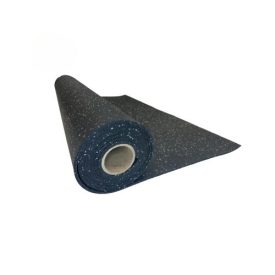
At 100 square feet per roll, the Living.Fit Rubber Flooring Rolls are a great value for your home gym. Each roll measures 4' by 25' with 8mm thickness and is made from recycled rubber buffings.
Specs
- Material: Certified clean rubber
- Thickness: 8mm
- Dimensions: 4′ x 25′
- Pieces Per Order: 1
- Price: $189.99
Pros
- At $1.90 per square foot, this is a budget-friendly flooring option.
- One roll is 100 square feet, about the size of a single-car garage.
- It’s made from recycled rubber buffings for exceptional cleanliness and durability.
Cons
- You’ll have to cut the flooring to size yourself, as it arrives in one continuous roll.
- Temperature and humidity can cause rubber to contract or expand, which may affect your stability.
Let’s face it, shelling out mega bucks on flooring isn’t the most fun use of your home gym budget (we’d much rather spend on a new power rack, personally). If that’s your approach too, we recommend the Living.fit Rubber Flooring Rolls as the best budget home gym flooring. At $1.90 per square foot, this option is among the most affordable flooring we researched, especially considering you’re getting 100 square feet with just one roll. As such, we rated it a 4.5 out of 5 for value.
You might be concerned that a cheaper gym flooring option means less durability in the long run. However, the Rubber Flooring Rolls are made from recycled rubber buffings (small pieces of rubber that come from recycled tires and other items). Not only does this make the Living.fit rolls a sustainable option, but recycled rubber is also more durable than similarly priced crumb rubber alternatives. Therefore, we gave this option a 4 out of 5 for durability.
One potential downside is that you will have to dust off your DIY spirit to install this home gym flooring. The flooring arrives in one long roll, and it’s up to you to measure, cut, and potentially adhere the flooring. Since we haven’t tested this flooring yet, we’re a little wary of how easy it may or may not be to install — so we gave it a 3 out of 5 for installation.
How We Tested and Chose the Best Home Gym Flooring
The BarBend team is made up of competitive athletes, certified personal trainers, and lifelong fitness enthusiasts. Many of us have often considered building a home gym of our own … and some of us have even taken the plunge. We’ve tested nine home gym flooring options and this is how we made our picks:
- Durability: How durable your home gym flooring is can be a somewhat subjective quality, but there are some areas that can indicate mat resiliency. For one, the material and its listed thickness can tell you a lot about how well the mat can withstand the rigors of holding equipment and supporting your workouts. We tested both rubber and EVA foam options with thicknesses ⅖ of an inch and up.
- Materials: In testing, we found that rubber mats were a denser option for training, making them a solid pick for weight training or housing fitness equipment. They could hold up our training better without squishing or pancaking out more often than not. EVA foam gym mats can still be worthwhile, hence their inclusion in this guide, but we’d recommend these more for spot coverage where you’re not housing any equipment or routinely dropping free weights.
- Thickness: We found that thicker materials worked better for sound dampening and floor protection, while thinner models were more lightweight and easier to toss around for assembly and storage. Thicker gym flooring was also typically heavier, which made installation more of a chore, so be sure to account for how permanent you’d like your training setup to be.
- Assembly and Installation: Home gym flooring typically comes in two forms — mats or large rolls. In testing, we found that the mat profiles were the most appealing for most athletes, as they’re easier to install, and you’re not left with a ton of trimming and cutting as you’d have with a large bundle of material. Mats typically measure roughly one meter squared, too, so you can think of covering your available space as a giant tiled floor. Some gym flooring options also boast an interlocking design that connects one mat to the next like a giant puzzle. This was our favorite, as the mats didn’t need extra adhesive. Plus, disassembling this option was a breeze. Lastly, we looked at home gym flooring ranging in weight. Heavier mats were more grounded in training but can be difficult to move into place, whereas lighter options could be easily thrown around and placed wherever needed.
- Aesthetics: You don’t need to compromise aesthetics for quality and performance. After all, if you’re planning to install new gym flooring into your home, you want it to look good. We picked products that look high-quality and offer plenty of color options. That way, you can find the product that best suits your home.
- Price: “Flooring is often overlooked in favor of more exciting home gym purchases, like shiny barbells and snazzy weight plates and colorful kettlebells,” notes BarBend expert reviewer Amanda Capritto, CPT, CES, CNC, CF-L1, CSNC. We understand that gym flooring isn’t exactly as exciting as a new power rack or specialty barbell — though it can be more expensive than both combined. That’s why we put a premium on the value that the floor mats provide. Some floor mats we chose may be more expensive than other options, but they’re made to last for decades and have inherent safety features. That said, we made sure to include some more budget-friendly options for those who need to count their pennies (like many of us do).
How Much Does Home Flooring Cost?
While it isn’t as fun spending your hard-earned cash on flooring, this investment is important to protect your home’s foundation. The chart below compares the costs of flooring for your home gym.
| Best Home Gym Flooring Overall | Living.Fit Gym Mat Flooring | $69.99 |
| Best Home Gym Flooring Over Concrete | Rubber Flooring Inc 8 mm Rubber Rolls | Starting at $1.49/square foot |
| Best Soundproof Home Gym Flooring | SecondSkin Stomp Mat | Starting at $99.99 |
| Best Stall Mats | Tractor Supply Horse Stall Mats | $58.99 |
| Best Rubber Flooring for Home Gym | PLAE Forge | Varies by estimate |
| Best Turf for Home Gyms | Rubber Flooring Inc Turf Rolls | $3.19/sq foot |
| Best Budget Home Gym Flooring | Living.Fit Rubber Flooring Rolls | $189.99 |
Benefits of Home Gym Flooring
Resistance training can improve self-esteem, cognitive ability, and cardiovascular health, but gleaning these benefits doesn’t need to come at the cost of your home’s foundation. (1) Home gym flooring can have a huge influence on your setup outside of just raising your placement up off the underfloor. Below are some of the benefits that can come with adding a few mats to your home. We understand that buying home gym flooring isn’t the sexiest of purchases, but these perks can be enough to sway your thoughts, in our opinion.
Equipment Protection
Adding some home gym flooring to your setup essentially adds a rubber or foam barrier between your exercise equipment and your structural flooring underneath. This barrier can serve as a buffer during training, softening any landings or hard drops you may experience in a workout. This “softer” landing can lessen the shock and force placed across your gear while also keeping your underfloor safe from chips, cracks, and other issues.
Noise Reduction
These training-focused layers of gym flooring can also help turn the volume down when it comes to your workouts. While some athletes may appreciate (and look forward to) that clang and bang feedback from a hard workout, those noises aren’t a shared sense of enjoyment for others like family members, neighbors, and sleeping babies. The shock-absorbing nature of home gym flooring helps lessen those vibrations, leading to less noise throughout training.
We cannot say that adding gym flooring to your home gym can completely soundproof your training area — you can still get some noise when dropping a weight plate from above — but it’s a far quieter experience than if you were to let the same weight fall onto uncovered concrete.
Professional Aesthetics
While it’s not a demand for every athlete, home gym flooring can also give your home gym a new sense of professionalism thanks to its clean look. The often black or crumb colorway can be a good way to spruce up your workout environment by making it look less like a rummage sale and more like a dedicated fitness center. Additionally, some home gym flooring comes in colors other than black, so there’s room to show off your personality as well.
[Related: How to Clean Home Gym Equipment]
What to Consider Before Buying Home Gym Flooring
“Your floor is literally the foundation of your home gym, so I encourage you to give it some thought. Good home gym flooring makes a massive positive difference,” notes Amanda Capritto, CPT, CES, CNC, CF-L1, CSNC. Buying home gym flooring is a good first step in your home gym renovation, and it helps to get your pick correct from the start. To ensure you lay a solid foundation for worthwhile training sessions, there are a few factors to consider.
Required Coverage
The area that you’re covering may seem straightforward — it’s the floor of your garage, basement, or commercial space. But home gym flooring is a little more complicated than, say, tossing down a throw rug. You’ll need to account for any pitches in the floor, present drains, or off-kilter walls if you’re planning on covering your entire floor plan. Additionally, if you’re placing a platform in your space, you’ll want to ensure that the chosen area is as level as possible.
When deciding on which gym flooring to go with, take a few measurements and see how much area you’d like to cover, along with any obstacles you need to account for. Will you be tossing kettlebells or dropping dumbells? Maybe you’d like some added coverage for plyometric work to supplement your athletic development. (2) Many home gym flooring options come in one-meter squared mats, so this can also be a good time to think about how much trimming you’ll need to do when adding your new layer of foam or rubber into your space.
Materials
What materials you decide to use for your gym flooring will be influenced by a variety of factors. For example, if you’re lifting in a basement or garage that has water seeping in when it rains, a wooden platform probably isn’t the best choice, and you may want to opt for water-resistant options. If you’re covering the entire floor, then heavy-duty rubber may be a great option too.
“Consider what type of flooring you want: Foam, rubber, turf, or something else? Rubber is the most popular option for its reasonable pricing, availability, and durability,” mentions Capritto. Some materials, like a thick and dense rubber compound, are also inherently more sound-absorbing and impact-resistant than others, so factor in what your neighbors may (not) want to hear and possibly feel.
Your Training Discipline
Your preferred training style can also influence your home gym flooring options. For athletes with an abundance of fitness equipment, rubber mats can be an ideal option as they’re more resilient and dense, meaning they won’t pancake out when under heavy machinery. Rubber can also absorb a good amount of impact and deaden more sound, which makes it a solid solution for weightlifters, powerlifters, and other strength athletes.
“Thickness is an important consideration, too. People who lift weights, especially heavy weights, should purchase flooring that is at least half an inch thick,” says Capritto. “Three-fourths of an inch is better, and 1 inch is best. The thicker the rubber, the more protecting your subflooring is.“
Foam flooring can be good for athletes looking to cover a carpeted area or those more focused on bodyweight training and aerobics. Additionally, these mats can be good for athletes in small spaces, as the foam is easier to move around and store if you need your home gym to share space with your other daily habits.
Your Budget
Home gym flooring can range in price, and it all depends on how much space you’re looking to cover. Mats can seem inexpensive at their individual price tag, with some coming in under $55 per square, but that total can quickly begin to add up if you’re trying to cover your entire floor plan. Be sure to crunch some numbers before loading up your cart and determine how many mats you’ll need to cover your space.
[Related: Best Exercise Bikes, Tested by Our Team]
FAQs
What is the ideal material and thickness for home gym flooring?
The ideal material and thickness for you will depend on a few factors, such as the type of lifting you’ll be doing and whether you want to move the floor mats around a lot. If you’re going to be performing heavy deadlifts pretty often, then a platform or exceptionally thick floor mat is a great option (0.5 inches or thicker). If you prefer to take your lifting outside onto the patio or driveway when the weather’s nice, then a thinner, yet still solid, mat that’s lighter and easier to maneuver will serve you well.
What is the best home gym flooring?
There are so many options for home gym flooring, from platforms to foam pads, but our favorite is the Living.Fit Gym Mat Flooring. It’s substantial without being cumbersome and priced well for its impressive quality. The pieces interlock nicely, so it’s not likely to move, and it doesn’t have any weird rubber smell like other mats might.
How much does home gym flooring cost?
Home gym flooring can start off inexpensive and escalate quickly depending on how much area you’re trying to cover. Pieces that are about one meter squared generally run from around $50 to $65, while platforms can be more expensive. You can pick up a basic platform for roughly $400, but if you want to accessorize it, the price can easily run over $1,000.
How do I care for and maintain my gym floor mats?
Most gym floor mats are made from heavy-duty rubber and require minimal real cleaning to upkeep. They’re not exactly Persian rugs. That said, make sure you vacuum up chalk fairly often and use an all-purpose cleaner to wipe up any pooling sweat. A monthly mopping can also help keep your setup pristine and clean, too.
During the hotter summer months, you may want to use the cleaning solution every two weeks instead of monthly. For other specialty gym flooring, refer to the cleaning suggestions provided by the company.
What if I can’t afford to cover my entire area with gym floor mats?
One of the nice things about home gym flooring options is that you can purchase as much or as little material as you can afford. While many brands have minimum order quantities of two or four panels, that still can leave you with a solid chunk of rubber or EVA foam for training purposes. Plus, there’s always room for adding on in the future — provided you stick with the same flooring tiles.
References
- Westcott W. L. (2012). Resistance training is medicine: effects of strength training on health. Current sports medicine reports, 11(4), 209–216. https://doi.org/10.1249/JSR.0b013e31825dabb8
- Morris, S. J., Oliver, J. L., Pedley, J. S., Haff, G. G., & Lloyd, R. S. (2022). Comparison of Weightlifting, Traditional Resistance Training and Plyometrics on Strength, Power and Speed: A Systematic Review with Meta-Analysis. Sports medicine (Auckland, N.Z.), 52(7), 1533–1554. https://doi.org/10.1007/s40279-021-01627-2